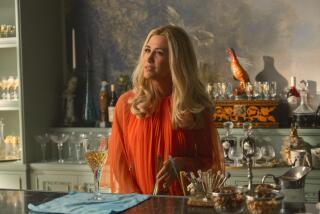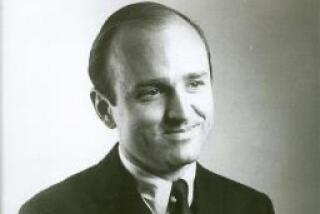Review: Showtime’s ‘I’m Dying Up Here’ finds the drama in comedy
“I’m Dying Up Here,” Showtime’s amiably dark new drama about comedy, takes its name and material, though not exactly its characters, from William Knoedelseder’s book of the same name. That volume’s focus was Mitzi Shore, her Comedy Store and the comics who played there in the 1970s, including Richard Lewis, David Letterman, Robin Williams, Elayne Boosler, Jay Leno, Tim Reid and Tom Dreesen, along with many lost to time; his narrative arc put them on a collision course, culminating in a 1979 strike against the club that sundered some relationships forever more.
A few names from real history are dropped in David Flebotte’s television adaptation, almost surreptitiously; there is a passing reference to “The Store,” a rival club that cannot exactly be the Comedy Store; there is, of course, “The Tonight Show” (with Dylan Baker as an un-Carson-like Johnny Carson), whose relocation from New York to Burbank in 1972 shifted the center of comedy west. (Paul Reiser’s upcoming Seeso series “There’s ... Johnny!” is also set in that milieu.) Here Shore is morphed, with seemingly only slight distortion, into Goldie (Melissa Leo), proprietress of the Sunset Strip comedy club she has named for herself and which she oversees as both domineering queen and nurturing mother — “my kids,” she calls the comics who play there, for free. (It’s a school, she says, and what school pays its students?)
While Goldie could only be a version of Shore, the performers have also been fictionalized and composited. (Canter’s Deli, it should be said, plays itself, frequently and well.) Now and again they suggest real-life counterparts, but they also range in type and attitude like the cast of any modern ensemble television show.
Michael Angarano and Clark Duke play Eddie and Ron, new kids in town, living in an actual closet they share with a cat box; RJ Cyler plays Adam, still on the outside, anxious for a shot; Erik Griffin is the emcee, a Vietnam vet; Andrew Santino is the designated angry guy, a political comic (his character’s name, Bill Hobbs, may be meant to suggest the late Bill Hicks); Stephen Guarino plays Sully, a goofball with a family to support. As Edgar, Al Madrigal, whose bits are the most consistently funny, makes jokes about his race (“I am Mexican, that’s right. I look like Tony Orlando had a baby … with Tony Orlando”). And Ari Graynor, the series’ warm heart and (intentionally or not) its center of attention, is Cassie, the woman.
Most are introduced in a Martin Scorsese-style tracking shot through the club one suspects was described in the script as “a Martin Scorsese-style tracking shot.”
Many of the series’ incidents and observations and issues are pulled from the pages of Knoedelseder’s book and compressed into a relatively short period in 1973, in the wake of the Carson move. Still, as a backstage drama it indulges in themes and tropes that run back to “Stage Door” and “42nd Street” regarding ambition and talent, artists and impresarios. It can feel a little predictable at times, even a little phony, including the odd meaningful speech made about purpose and authenticity.
“Real laughter, it’s cathartic — it’s the current that moves through an audience when some truth about who you are, who they are, is revealed,” says Clay (Sebastian Stan), a comic meant to embody a newer, more personal sort of stand-up, in which he invited strangers, as Eddie says, to “laugh at the most embarrassing, shameful, painful moments of his life.” (“I’m Dying” is in many respects as much about comedy since 1973 as the comedy of 1973.)
Clay in fact is dead when he says this — as an embodied bit of conscience — to ex-girlfriend Cassie, who is about to get her first shot on the club’s main stage. This is not quite a spoiler: From the moment, early in the opening hour, when he pays cash to check into what any person familiar with Strip history will recognize as a version of the Continental Hyatt House, to watch his “Tonight Show” debut, his fate is pretty well telegraphed. But Clay doesn’t stick around — this is not a ghost story.
In a way, it’s a comedy-world West Coast version of “Vinyl,” the short-lived Martin Scorsese-Mick Jagger HBO series about rock ’n’ roll in early-’70s New York. (Jim Carrey, an executive producer of “I’m Dying,” is the Jagger in this equation, I suppose.) But it has a warmer heart.
In spite of the feuds and flaws and dysfunctions assigned its characters — “They got mommy issues, they got daddy issues, they’re about as stable as a Middle East cease fire,” Goldie says of her comics — they’re mostly likable and do make a sort of family, mutually supportive despite their competition for stage time and dialogue composed two-thirds of traded insults. Although the series tempers nostalgia with sobriety, it doesn’t seek to scrape the shine from a golden age. There is no suggestion, whatever issues drive them, that their common mission is less than holy: Laughter, it’s the best medicine.
Follow Robert Lloyd on Twitter @LATimesTVLloyd
ALSO:
The birth of modern stand-up is chronicled in Jim Carrey-produced ‘I’m Dying Up Here’
These real-life comics take retro trip to the ‘70s in ‘I’m Dying Up Here’
Mitzi Shore: Still Minding the Store
More to Read
The complete guide to home viewing
Get Screen Gab for everything about the TV shows and streaming movies everyone’s talking about.
You may occasionally receive promotional content from the Los Angeles Times.







